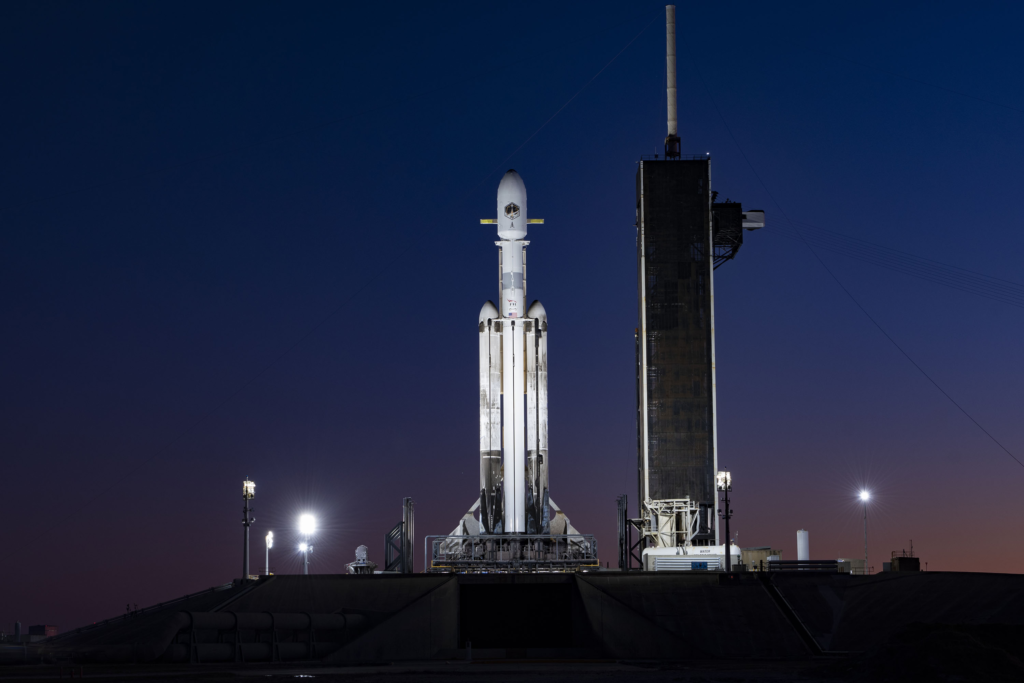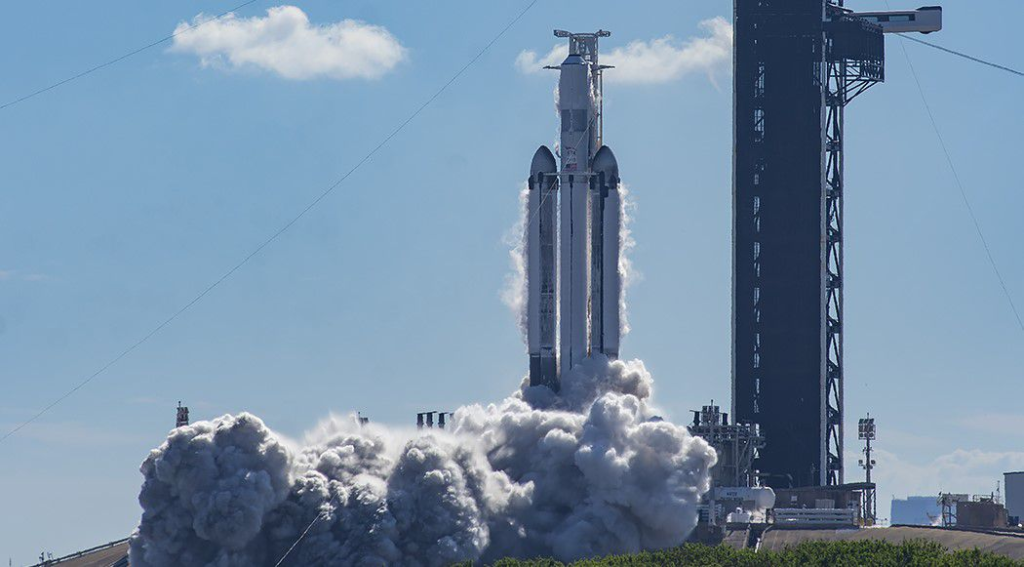
Why Did Falcon Heavy Have A Gray Band, Expendable Core, & More
It has only been a few weeks in 2023 and Falcon Heavy just successfully launched for the first time this year. Yesterday’s launch was apart of the USSF 67 mission which featured a lot of similarities to the previous USSF 44 launch. Here we saw liftoff, a dual side booster landing, and eventually the deployment of this payload to its destination.
While many aspects of this launch were routine, there were a few unique aspects that correlated to specific mission requirements. For one, Falcon Heavy featured a gray band toward the top of the launch vehicle. In addition, the center core was in an expendable configuration with no grid fins or landing gear and never attempted to touchdown after launch.
In this case, both of these aspects were mission specific to make sure that the payload could reach its distant orbit factoring in size, and weight, just to name a few. Something we can expect to see change in the near future as more launches are scheduled with this launch vehicle. Here I will go more in-depth into yesterday’s launch, why it featured a gray band and expendable core, when are Falcon Heavy’s next launches, and more.
Gray Band & Core

Yesterday’s Falcon Heavy launch lifted off at 5:56 pm ET. Soon after it cleared the pad and began accelerating. 1 minute and 15 seconds in it reached Max q without any issues and continued on. Only 2 minutes and 30 seconds into the launch and both side boosters were shut off and then separated from the center core and upper stage. They then performed a boost back burn soon after. 4 minutes into the launch and the center core engine was cut off before separating from the upper stage. At this point, the center core was done with its mission and did not return for a droneship landing as it was in an expendable configuration.
After falling back toward earth for a few minutes, the two side boosters completed their entry burns 6 minutes and 40 seconds into the mission. Right around 7 minutes and 40 seconds into the launch, both boosters successfully touched down with only seconds between their landings. Soon after SpaceX’s official live stream ended and no other information was provided. These U.S. Space Force missions often keep a lot of the mission profile and details of the payload hidden which has to do with what we saw yesterday. Altogether SpaceX confirmed a successful launch with every aspect going according to plan.
With this in mind, we can take a closer look at the gray band and why it’s so important. So far we have seen the addition of this gray band on the previous Falcon Heavy launch, and multiple Falcon 9 launches as well. The gray band has to do with thermal conductivity into the RP-1 kerosene propellant tank portion of the second stage. Maintaining fuel (RP-1 kerosene) and oxidizer (densified Liquid Oxygen) temperatures in the second stage can be a challenge for long coast missions which sometimes require the propellants to be thermally maintained or reconditioned up to six hours after launch.
In other words, Falcon Heavy featured a gray band due to a long coast phase between subsequent burns. This allows more heat from sunlight to be absorbed to warm the RP-1 kerosene tank during the longer coasting period, the second time for Falcon Heavy and fourth for any falcon rocket. When it gets too cold, kerosene – which freezes at a much higher temperature than Falcon’s liquid oxygen oxidizer – becomes viscous and slush-like before it freezes solid. If ingested, slushy fuel would likely prevent ignition or destroy the upper stage’s Merlin engine. Based on continued use from SpaceX, it seems this change has worked quite well. In the future, we can expect to see this gray band not only on Falcon Heavy but also on the occasional Falcon 9 launch too.
Lastly, as partially mentioned prior, this launch featured an expendable center core. This mission launched the payload into a distant orbit, necessitating for the second time a planned partially expendable launch, that is, to deliberately expend the center core which lacks grid fins and landing gear needed for a landing. When launching a reusable rocket such as Falcon Heavy, the cores require a reserve of propellants in order to reach their landing destination and slow down enough for a soft landing. In an expendable configuration, every ounce of fuel and propellant can be used to push the payload as far as possible. Something we see with very distant orbits combined with massive payloads.
Future Schedule

Now that we know more about yesterday’s launch and some of its unique features, we can take a closer look at Falcon Heavy’s busy upcoming schedule and what to look out for. To put it in perspective, as of right now, there are at least 9 missions by the end of 2024 either scheduled or planned to happen using the Falcon Heavy. Quite an increase in expected launch cadence from the multiple years without a launch.
To start off, not long ago the ViaSat-3 satellite was scheduled to lift off in December one month prior. However, Viasat said that its first ViaSat-3 broadband satellite will not be ready to launch on SpaceX’s Falcon Heavy rocket in 2022. Instead, the company now expects the satellite will be shipped from Boeing’s manufacturing facilities in California to SpaceX’s launchpad in Florida soon enough to facilitate an early 2023 launch. In addition, ViaSat-3’s deployable subsystems are currently being inspected and reintegrated into the launch configuration following successful environmental and ground tests. Mark Dankberg, the CEO of Viasat commented that they are working with SpaceX to target a launch with Falcon Heavy in the early part of next year’s first quarter and that it depends on the timing of some U.S. national priority launches.
Falcon Heavy was slated to launch the Viasat-2 satellite, but due to delays, an Ariane 5 launch vehicle was used instead. While not ideal, Viasat maintained the launch option and will launch its next Ka-band satellite, which will serve either the Asia-Pacific, Europe, Middle East, Africa, or Americas regions, using Falcon Heavy. During this mission, the upper stage of Falcon Heavy will deploy the satellite into a near-geosynchronous orbit that will include a coasting stage several hours long between burns.
As far as the payload itself, ViaSat-3 is planned to be a global satellite constellation consisting of three high-capacity Ka-band satellites that are expected to increase the coverage and capacity of the company’s network with the goal to bring high-quality, low-cost connectivity where it’s needed most. Each ViaSat-3 satellite is expected to have more than 1 Terabit per second (Tbps) of throughput capacity, making them the highest-capacity broadband satellites ever launched. The idea is, from air to land to sea, ViaSat-3 satellites will serve homes, businesses, communities, airlines, business jets, and enterprises such as energy, militaries, and governments. As each satellite launches, service in that region will “turn on.”
Some of the other missions that could happen include another launch in January, then April, October, and into 2024. It’s possible that in October of 2024 Falcon Heavy will help NASA launch the Europa Clipper. Specifically, Europa Clipper will conduct a detailed survey of Europa and use a sophisticated suite of science instruments to investigate whether the icy moon has conditions suitable for life. Key mission objectives are to produce high-resolution images of Europa’s surface, determine its composition, look for signs of recent or ongoing geological activity, measure the thickness of the moon’s icy shell, search for subsurface lakes, and determine the depth and salinity of Europa’s ocean. The mission will fly past Mars and Earth before arriving at Jupiter in April 2030. Back in 2021 NASA awarded this launch to SpaceX and Falcon Heavy for a price of around $178 million. Just a few examples of exciting upcoming missions we could see happen.
Taking a closer look at the rocket itself and specifically its boosters, also help highlight the overall system and mission based decisions the company makes. One of the most fascinating parts about Falcon Heavy and an original design challenge for SpaceX has to do with the three side by side boosters. The fundamental purpose of the side cores is to apply axial force to the center core during ascent and increase the impulse delivered to the second stage before stage separation. The timing of the shutdown for the Falcon Heavy side cores can be tailored for each mission to ensure that the proper impulse is delivered. Each side core is structurally connected to the center core at forward and aft locations. Two pneumatic pusher separation mechanisms connect the forward ends of each side core to the center core, fastening the top of the LOX tank in the center core to the side cores. They maintain the connection during ascent and then actively jettison the side cores following side core shutdown. Two identical pusher separation mechanisms connect the aft ends of each side core to the center core and are used to laterally force the base of the side cores from the center core following the side core shut down.
Conclusion
SpaceX and the Falcon Heavy just completed another successful launch and the first of 2023. While exciting, quite a few more missions are scheduled just around the corner with this rocket. Yesterday’s launch featured a gray band and expendable core due to the orbit and ensuring temperatures were exactly where they needed to be. We will have to wait and see how it progresses and the impact it has on the space industry.
